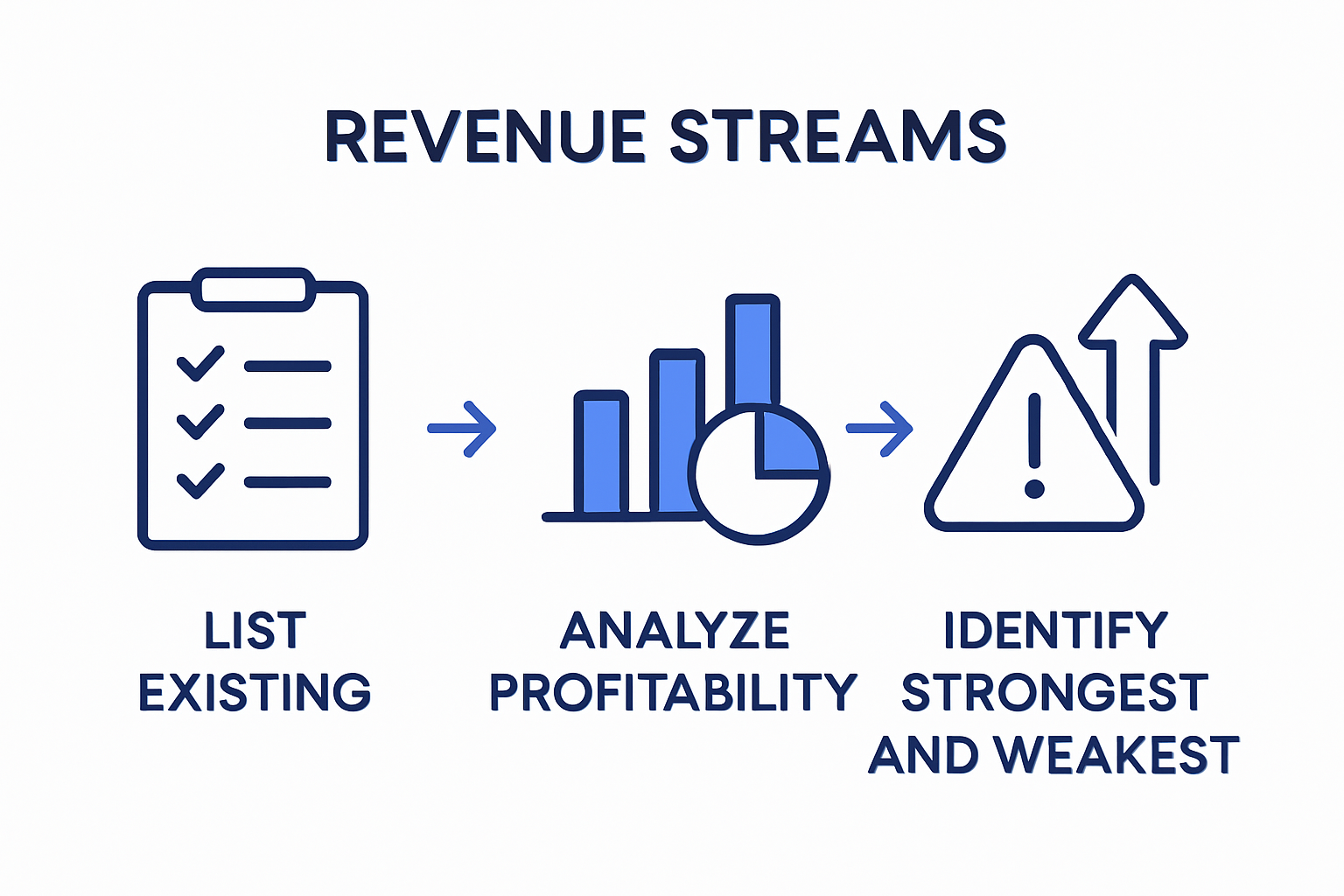
Every business owner wants to see their revenue grow and their hard work pay off in bigger ways. Yet surprisingly, some businesses discover hidden revenue opportunities just by reviewing their current income streams with fresh eyes. Most people assume major growth demands risky new ventures or overhauling everything but the real shift starts by making smarter moves right where you already stand.
Table of Contents
- Step 1: Evaluate Your Current Revenue Streams
- Step 2: Identify Opportunities For New Revenue Channels
- Step 3: Optimize Your Pricing Strategy
- Step 4: Enhance Your Marketing Efforts
- Step 5: Monitor Performance And Adjust Strategies
Quick Summary
| Key Point | Explanation |
|---|---|
| 1. Audit Existing Revenue Streams | Conduct a thorough evaluation of all current income sources to identify strengths and weaknesses. |
| 2. Explore New Revenue Opportunities | Research market trends and client needs to develop innovative products or services addressing unmet demands. |
| 3. Optimize Your Pricing Strategy | Adjust pricing structures to reflect value and align with market expectations, potentially using tiered packages. |
| 4. Implement Targeted Marketing Approaches | Develop marketing strategies that resonate with your ideal clients, focusing on their specific challenges and interests. |
| 5. Establish Performance Tracking System | Monitor key performance indicators consistently to make informed adjustments that drive business growth. |
Step 1: Evaluate Your Current Revenue Streams
Increasing business revenue starts with a comprehensive understanding of your existing income sources. This crucial first step involves conducting a thorough audit of how money currently flows into your business, identifying both strong performers and potential areas of improvement.
Mapping Your Income Landscape
Begin by creating a detailed breakdown of every revenue channel you currently operate. This means examining each service, product, or income stream with precision. Pull out your financial statements, track records, and client invoices to get a crystal clear picture. Some businesses discover hidden opportunities for increasing business revenue simply by closely examining their existing income patterns, and this focus on increasing business revenue can drive long-term growth.
For service providers and solopreneurs, this typically involves categorizing income sources such as:
- Direct client services
- Digital product sales
- Consultation packages
- Group program offerings
- Passive income streams
As you compile this information, look beyond just total revenue.
 Analyze the profitability of each stream by calculating not just gross income, but net income after accounting for associated costs.
Analyze the profitability of each stream by calculating not just gross income, but net income after accounting for associated costs.
According to research from the Academy of Management Perspectives, understanding the nuanced performance of each revenue channel is fundamental to strategic business growth.
Performance Evaluation Strategies
Once you have mapped your income streams, apply a critical lens to each one. Which services generate the most consistent revenue? Which require the least effort but produce significant returns? Conversely, identify streams that consume substantial time and resources while delivering minimal financial results, and focus on increasing business revenue through better allocation.
This evaluation isn’t just about eliminating underperforming channels. It is about understanding their potential and determining whether they can be optimized, repositioned, or transformed. Some revenue streams might need strategic refinement rather than complete elimination.
Consider metrics like client acquisition cost, time investment, and profit margin when assessing each income channel. These insights will become the foundation for your revenue growth strategy, guiding future decisions about service development, pricing, and business focus with the aim of increasing business revenue.
Here is a step overview table summarizing each major phase in the revenue-boosting process, including their main objectives and expected outcomes for better clarity and quick reference.
| Step | Objective | Key Outcome |
|---|---|---|
| Step 1: Evaluate Current Revenue Streams | Assess all existing income channels | Identify strengths, weaknesses, and hidden revenue opportunities |
| Step 2: Identify New Revenue Channels | Explore and develop new streams based on market demand | Expand and diversify business income sources |
| Step 3: Optimize Pricing Strategy | Analyze and adjust pricing structures | Maximize profitability and perceived client value |
| Step 4: Enhance Marketing Efforts | Develop targeted marketing approaches | Attract new clients and improve engagement |
| Step 5: Monitor and Adjust Strategies | Track key performance indicators | Make data-driven improvements for sustainable business growth |
Step 2: Identify Opportunities for New Revenue Channels
After thoroughly evaluating your existing revenue streams, the next critical step for increasing business revenue involves strategically exploring and developing new income opportunities. This process requires creativity, market research, and a willingness to experiment with innovative approaches to monetization.
Exploring Potential Revenue Expansion
Start by conducting comprehensive market research to understand emerging trends and unmet needs within your professional ecosystem. Pay close attention to the pain points your current clients experience, as these often represent untapped revenue potential. For service providers, this might mean developing complementary offerings that solve adjacent problems or creating more comprehensive service packages.
According to research exploring organizational revenue strategies, successful businesses frequently diversify their revenue channels by adapting their core offerings to serve different market segments. This could involve:
- Creating digital products related to your expertise
- Developing online courses or training programs
- Offering group coaching or workshop experiences
- Designing scalable information products
- Exploring affiliate or referral partnerships
Strategic Revenue Channel Development
As you brainstorm new revenue channels, consider the unique intersection of your skills, market demand, and scalability. The most successful new revenue streams will align closely with your existing expertise while addressing specific client needs. This might mean transforming your one-on-one services into group programs, creating digital downloads that complement your primary offerings, or developing recurring subscription-based services.
Critical to this process is understanding the minimal additional effort required to launch these new channels. Look for opportunities that leverage your existing knowledge and infrastructure, allowing you to create additional income streams without significant upfront investment. Test these new revenue channels incrementally, gathering client feedback and refining your approach with a clear focus on increasing business revenue.
Verify the potential of your new revenue channels by establishing clear metrics for success. Track initial engagement, conversion rates, and profitability. Be prepared to pivot quickly if a particular channel does not meet your expectations, remembering that increasing business revenue often requires multiple iterations and continuous refinement.
The following table compares different types of new revenue channels mentioned in the article, summarizing their focus and advantages to help you choose the most suitable expansion opportunities for your business.
| Revenue Channel Type | Main Focus | Potential Advantage |
|---|---|---|
| Digital Products | Selling knowledge or tools online | Scalable and low ongoing effort |
| Online Courses/Training | Teaching expertise to groups virtually | Generates recurring or passive income |
| Group Coaching/Workshops | Facilitating collective learning or support | Higher reach without more work per client |
| Information Products | Downloadable resources or guides | One-time creation, repeated sales |
| Affiliate/Referral Partnerships | Promoting others’ products or services | Earn commissions without direct fulfillment |
Step 3: Optimize Your Pricing Strategy
Pricing is more than just attaching a number to your services. It is a strategic tool that directly impacts your ability to attract clients, communicate value, and ultimately increase business revenue. This step involves carefully analyzing and adjusting your pricing approach to maximize profitability while maintaining market competitiveness.
Understanding Pricing Psychology
Pricing is a psychological game as much as a mathematical calculation. Your rates communicate your expertise, value, and professional positioning. Many service providers undervalue their work, setting prices that fail to reflect their true worth. Start by conducting thorough market research to understand the pricing landscape in your specific industry and service niche.
Consider developing a pricing strategy that includes multiple tiers or packages. This approach allows potential clients to choose options that best match their budget and needs while providing you flexibility in service delivery. For instance, increasing business revenue can be supported by offering:
- Basic package with core services
- Standard package with additional support
- Premium package with comprehensive solutions
- Custom consultation options
According to research from the Fisher College of Business, effective pricing strategies require understanding both your costs and your clients perceived value. This means going beyond simple cost-plus pricing and developing a nuanced approach that considers market positioning, client expectations, and your unique value proposition.
Strategic Pricing Implementation
Transitioning to an optimized pricing strategy requires careful execution. Begin by testing new pricing structures with a segment of your existing client base or through targeted marketing campaigns. Track client responses, conversion rates, and overall revenue impact meticulously. Be prepared to make incremental adjustments based on real-world feedback.
Consider implementing value-based pricing where you charge based on the tangible results and transformations you deliver rather than time spent. This approach shifts the conversation from hourly rates to the significant impact of your services. Clients become more focused on the outcomes you can generate rather than the hours you work.
Verify the success of your new pricing strategy by monitoring key metrics such as client acquisition rate, average transaction value, and overall revenue growth. Remember that pricing is not a one-time decision but an ongoing process of refinement and adaptation to market dynamics.
Step 4: Enhance Your Marketing Efforts
Marketing is the engine that drives client acquisition and business growth. To support increasing business revenue, your marketing strategy must evolve from traditional approaches to more targeted, strategic communications that resonate deeply with your ideal clients.
Crafting a Targeted Marketing Approach
Effective marketing is about precision, not just volume. Begin by developing a crystal-clear understanding of your ideal client persona. This means going beyond basic demographics to understand their specific challenges, aspirations, and communication preferences. Your marketing messages should feel like a direct conversation, addressing their unique pain points with empathy and expertise.
Consider developing a multi-channel marketing strategy that includes:
- Targeted social media content
- Personalized email marketing campaigns
- Professional networking engagement
- Content marketing through blogs or podcasts
- Strategic partnerships and collaborations
According to research from the U.S. Small Business Administration, local marketing strategies can significantly enhance your business visibility. This might involve participating in online professional groups, sponsoring local events, or cross-promoting with complementary businesses in your professional network.
Strategic Marketing Implementation
Transform your marketing from generic broadcasts to personalized experiences. Digital platforms offer unprecedented opportunities for precise targeting and engagement. For service providers, this means leveraging tools that allow you to learn more about ad management for promoting your services. Explore retargeting strategies that keep your brand top of mind for potential clients who have shown initial interest.
Track your marketing efforts meticulously. Use analytics tools to measure engagement rates, conversion metrics, and return on investment for each marketing channel. Be prepared to quickly adjust your strategy based on real-world performance data. Some channels will naturally perform better than others, and your willingness to adapt is crucial for increasing business revenue.
Verify your marketing strategy’s success by monitoring key performance indicators such as lead generation rates, client acquisition costs, and the quality of incoming inquiries. Remember that great marketing is an ongoing process of refinement, always aligning your messaging with the evolving needs of your target audience.
Step 5: Monitor Performance and Adjust Strategies
Increasing business revenue is not a one-time event but a continuous process of measurement, analysis, and strategic refinement. This final step focuses on developing a robust system for tracking your business performance, interpreting the data, and making informed adjustments that drive sustainable growth.
Creating a Performance Tracking Framework
Successful businesses treat data as their most valuable asset. Establish a comprehensive performance tracking system that goes beyond simple revenue numbers. Create a dashboard that captures multiple key performance indicators (KPIs) relevant to your specific business model. This might include metrics such as client acquisition cost, conversion rates, average transaction value, client retention rates, and overall profitability.
Implement tools and processes to collect and analyze this data consistently. Consider using:
- Financial management software
- Customer relationship management (CRM) systems
- Analytics platforms
- Spreadsheet tracking templates
- Periodic performance review protocols
According to research published in the National Institutes of Health, systematic performance monitoring enables organizations to identify performance gaps and enact timely strategic adjustments. This approach transforms data from a passive record into an active tool for business improvement.
Strategic Data-Driven Adaptation
Data collection alone is not enough. The real power lies in your ability to interpret and act on these insights. Schedule regular review periods monthly or quarterly to deeply analyze your performance metrics. Look for patterns, emerging trends, and potential areas of improvement across your revenue streams, pricing strategies, and marketing efforts.
Be prepared to make bold yet calculated adjustments. If certain revenue channels are underperforming, do not hesitate to pivot or phase them out. Conversely, double down on strategies and services that consistently demonstrate strong performance and client satisfaction to ensure increasing business revenue.
Verify the effectiveness of your performance monitoring by ensuring you have a clear, repeatable process for data collection, analysis, and strategic adjustment. Your goal is to create a dynamic feedback loop that keeps your business agile, responsive, and continuously evolving while increasing business revenue.

Remember that increasing business revenue is not about perfect execution, but about consistent learning and strategic adaptation.
Ready to Transform Your Revenue With Simpler Solutions?
Feeling overwhelmed by handling so many revenue streams, pricing changes, and constant marketing updates? If you are looking to actually implement the strategies from “Boost Your Profits: Strategies for Increasing Business Revenue,” you need tools that take the guesswork and manual work out of business growth and automation for solopreneurs.

Join other high-achieving service providers using Fluum.ai to build powerful sales funnels, manage bookings, collect payments, and automate your client management process all in one place.
Take your first step now by viewing our straightforward pricing plans and discover how easy it is to put proven strategies into action. Experience how it feels to stop juggling multiple tools and finally have the all-in-one system that scales with your goals. Don’t let inefficiency or wasted time hold your business back any longer. Get started today and watch your revenue rise.
Frequently Asked Questions
What are the first steps to evaluate my current revenue streams?
Start by conducting a comprehensive audit of your existing income sources. Create a detailed breakdown of every revenue channel, including services, products, and other income streams. Analyze total and net income for each stream to identify both strong performers and areas for improvement with the goal of increasing business revenue.
How can I identify new revenue opportunities for my business?
Conduct market research to understand emerging trends and unmet needs among your clients. Pay attention to their pain points and consider developing complementary offerings or creating scalable information products that address these needs while increasing business revenue.
What strategies can I use to optimize my pricing?
Adopt a pricing strategy that reflects your expertise and client value, which could include multiple tiers or packages. Increasing business revenue can also be achieved by implementing value-based pricing, where clients pay based on the results you provide, and this focus on increasing business revenue goes beyond simply charging for the time spent on services.
Why is it important to monitor performance and adjust strategies?
Monitoring performance is crucial as it allows you to collect data on key metrics, identify areas for improvement, and make informed adjustments. This ongoing process ensures your business remains agile, responsive to market needs, and continuously evolving to maximize revenue.



